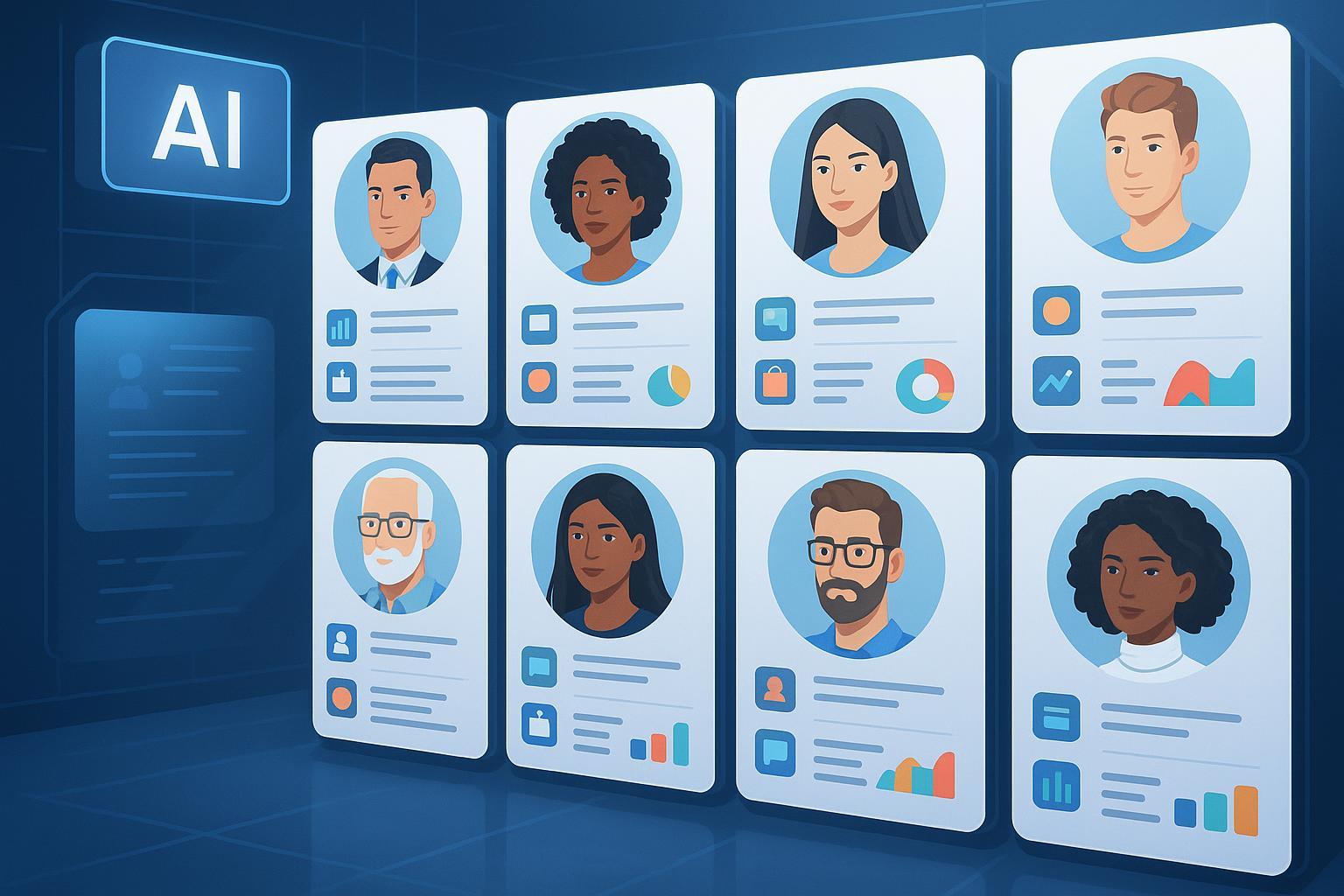What Are Synthetic Personas? The 2025 Guide for SaaS, Content Marketing, and AI Professionals

Introduction: Why Synthetic Personas Matter in 2025
If you’ve worked in content marketing, SaaS product development, or digital customer research, you likely know the struggle: understanding your audience at scale, moving fast without sacrificing insight, and managing privacy concerns. Enter synthetic personas, an AI-powered revolution transforming how teams test, design, and tailor experiences—without the old bottlenecks of manual research or the privacy pitfalls of real user data.
But what exactly are synthetic personas, how do they work, and why are they suddenly everywhere from SaaS onboarding to AI blog creation workflows? Let’s break it down with clarity, depth, and real-world relevance.
Quick Glossary: Key AI Terms Behind Synthetic Personas
Before we dive in, it helps to ground ourselves in a few essential concepts:
| Term | Definition |
|---|---|
| Large Language Models (LLMs) | AI models trained on huge troves of text to converse, analyze, and generate humanlike dialogue. |
| Generative AI | Technology that creates new data/content (like personas or scenarios) from learned patterns. |
| Psychographics/Demographics | Personal and population-level attributes—think age, job, goals, values, behavior—in personas. |
| Persona Modeling | Using data and AI to build detailed, dynamic user archetypes. |
| Synthetic Data | Made-up (but plausible) data used for modeling, safety, or privacy-preserving analysis. |
For more technical depth, see Delve AI’s glossary of synthetic personas terms.
Core Definition: What Are Synthetic Personas?
Synthetic personas are data-driven, AI-generated user profiles that simulate real people (or groups) for use in research, marketing, design, and digital experience testing. Unlike traditional, static personas crafted from survey or interview snippets, synthetic personas are dynamically modeled by algorithms—often powered by Large Language Models (LLMs) and other forms of generative AI—using massive, anonymized datasets.
Think of synthetic personas as your interactive, on-demand focus group: scalable, diverse, tireless, and instantly queryable within digital environments. Used right, they help:
- Rapidly test content, campaigns, or product flows
- Personalize user journeys at scale (without sacrificing privacy)
- Predict shifting audience behaviors before you launch
For a recent deep-dive, see Bluetext’s analysis of synthetic personas in modern customer research.
Synthetic vs. Traditional Personas: A Side-by-Side View
So, what actually changes when you swap a classic persona out for a synthetic one?
| Aspect | Synthetic Personas | Traditional/User Personas |
|---|---|---|
| Creation | AI/LLMs generate persona from vast, often real-time data | Built by humans, from surveys/interviews |
| Updates | Continuously updatable, dynamic | Static, periodic manual refresh |
| Interaction | Interactive, scenario-simulating, can converse/test in real-time | Descriptive, not interactive |
| Scalability | Thousands possible; instant new segment creation | Typically a handful at best |
| Privacy | No real user details required; easier to anonymize | Risk of leaking/stereotyping real users |
| Best For | Large-scale, data-driven, dynamic testing | Deep empathy, early-stage product ideation |
Check out NN/g’s practical guide to synthetic users for a detailed breakdown.
How Are Synthetic Personas Created? (The 2025 Workflow)
Synthetic personas aren’t conjured out of thin air—they’re generated through a multi-layered AI process. Here’s how it typically works in a SaaS or content-focused business today:
- Data Gathering & Cleansing: Collect broad, privacy-compliant behavioral, demographic, and synthetic data from analytics, CRM, surveys, and more.
- AI Modeling (Driven by LLMs): Feed this data into AI models, which synthesize it into nuanced persona “profiles” capable of simulating attitudes, preferences, and responses.
- Bias Detection/Mitigation: Use fairness tools to balance data and flag stereotype risks—e.g., auto-checking whether a persona’s traits skew unfairly.
- Human Oversight & Validation: Analysts test for realism and accuracy; outputs are caught early before being used in major research or product work.
- Deployment & Monitoring: Personas are embedded in workflows (such as generative blog platforms or SaaS onboarding simulations) and monitored for accuracy, drift, and bias.
Recent technical developments—like NVIDIA’s Nemotron and IBM’s CEO studies—push these steps to new levels, making the process faster, safer, and more robust.
Real-World Business Applications: 2024–2025 in Action
Content Marketing
- B2B SaaS Campaigns: Teams use synthetic personas to simulate how multiple customer types react to different messaging—rapidly optimizing campaigns before spending on actual ads. Reports show up to 10–15% improvement in sales efficiency, with 83% of marketers achieving better lead generation (Martal).
Training and Enablement
- Xerox Global Training: Used AI-driven persona videos to cut global training and video costs by 50% and delivery time by 30% (Synthesia case).
SaaS Product Design
- Dynamic User Testing: SaaS firms simulate onboarding and UX flows for startups, enterprises, and freelancers using synthetic personas drawn from both public and synthetic datasets—identifying bottlenecks and friction points before launch.
Personalized, Yet Private Experiences
- Adaptive training platforms (e.g., Hoxhunt) employ synthetic personas to create realistic phishing and security drills, enabling safer, more tailored learning without exposing real user info (Hoxhunt).
Privacy, Regulation, and Ethics in Synthetic Persona Use
Why Privacy Standards Matter
As synthetic personas become a digital backbone, privacy and explainability are not optional. In the U.S., new laws (Tennessee ELVIS Act, California privacy acts) restrict unauthorized AI use of real likenesses and demand transparency. In the EU, the GDPR and pending AI Act require clear disclosure, auditability, and explicit provenance tracking, especially where synthetic profiles could be traced back to individuals (Gunderson Dettmer on AI law).
Best Practices:
- Always track how and from what data personas are made (provenance)
- Build in bias detection; document all model decisions
- Seek consent and explain synthetic persona use to end-customers, where relevant
Learn more in the EU EDPB’s 2025 AI privacy guidelines.
Making It Real: Analogies and Future Scenarios
- Flight Simulator for Marketers: Just as pilots use virtual simulators before flying real planes, marketers use synthetic personas to test campaigns, products, and ideas—virtually, safely, and at scale.
- Instant Focus Groups: Need feedback from a New York freelancer, Berlin enterprise IT manager, and Tokyo student? Synthetic personas let you “launch” diverse global focus groups in seconds, not weeks.
- Growing Story Characters: Instead of static “storybook” personas, synthetic personas evolve—gathering new context as your business, data, and market shift.
2025 SaaS Launch Narrative
Imagine you’re rolling out an AI-powered project management SaaS. Before users ever log in, you use synthetic personas—representing fast-paced startups, large corporates, and digital agencies—to simulate onboarding, identify pain points, test feature language, and optimize value communication. The result? Fewer surprises at launch, higher early adoption, and data-driven insight into what really drives user success (Forbes analysis).
Related Concepts: Building Your Synthetic Knowledge Web
| Concept | Defined As | How It Connects |
|---|---|---|
| Synthetic Data | Fake but plausible data for testing/training | Fuels the creation of synthetic personas |
| Digital Twins | Real-time virtual replicas of actual users | Dynamic version of a synthetic persona |
| Behavioral Simulation | AI models that predict user behavior/responses | Core engine for persona interaction |
| AI Avatars | Embodied, interactive personae/agents | Bring personas to life in SaaS or CX |
See more at Q2 Insights’ 2025 event summary.
Closing Thoughts: What’s Next?
Synthetic personas are no longer experimental—they’re the new baseline for advanced, privacy-first digital marketing and SaaS innovation. When implemented with care, they enable ethical, scalable, and truly data-driven user insight—empowering teams to keep up with 2025’s pace of change.
Explore further:
- Delve AI: Are Synthetic Personas the New Normal?
- NN/g: Synthetic Users—If, When, and How to Use AI-Generated Research
- IBM CEO Study—AI and Customer Experience 2025
If you’re building, marketing, or optimizing anything digital in 2025, synthetic personas aren’t “nice to have”—they’re fast becoming essential.

